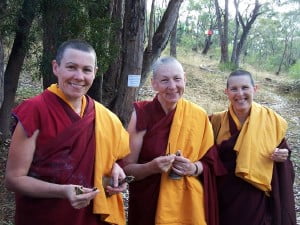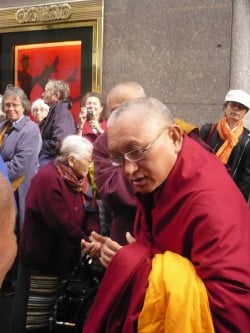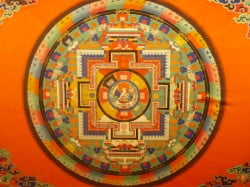Sojong as Skillful Means for Building Community
By Bhikshuni Thubten Saldon
Today more than ever, I am deeply reassured about the potential of Sojong for the Western Sangha. The practice of or Sojong supports both the individual and the community by the dismantling of harmful karmic conditionings. Again and again, I have experienced the huge potential for transformation set up for us in the format of the Posada ceremony by the Buddha.
Just a few days ago, I had the fortune to participate in the Sojong ceremony with the community at Sravasti Abbey. I’m thrilled to see how this practice has evolved over the past two years. Ven. Thubten Chodron is adapting certain aspects of the formal procedure in order to make it more accessible and deeply meaningful to those of us in the West.
The ceremony begins with the entire community gathering in the meditation hall to sing verse eight from The Extraordinary Aspiration of the Practice of Samantabhadra. Between each repetition of the verse, which is done three times, the community prostrates once. The verse that is sung in English, has been adapted to a Chinese melody that is commonly used at most Chinese monasteries. It is working beautifully despite the challenges that the singing style presents to westerners. The verse expresses our deep-felt repentance for the unskillful deeds of body speech and mind that we have committed along our present and past lives.
After the repentance verses, the fully ordained recite the Sojong Blessings*, then the Abbess receives confession from the other bhikshunis, she then confesses herself, and afterwards she takes confession from the novices. The anagarika and lay community recite the refuge prayer and the five precepts in a separate location.
This is just an example of one of many ways in which Sojong could be performed in western monasteries. Gampo Abbey has developed a far longer and comprehensive ceremony closer to the Mulasarvastivada version while Ven. Thubten Chodron’s one is closer to the Dharmagupta’s version in simplicity and spirit. At Vajradakini Nunnery, Abbess Khenmo Drolma is translating to English for the first time the Drikung Kagyu Sojong version, and her vision is that Posada days would be the occasion for the community to study the Vinaya.
In the West, we are beginning a dialogue about what approach the monastic community can take in order to perform this ritual in a way that becomes a rich practice and nurtures us to transform our minds by burning the karmic propensities that keeps us bound in samsara.
Let’s have a look at a traditional quotation and see how we can apply its wisdom today.
Vasubandhu, describing Sojong said that is about, “To fully restore all that is positive and supportive and to clear away all that weakens us and causes harm. To replenish insight and courage and purify habitual patterns, the Tath?gata has taught the practice of Sojong.”
 Replenish and purify are actually the key words here, unfortunately this last word “purify”, in my opinion, has the negative moralistic connotation of purity vs. impurity, so let’s use an updated concept, free of puritanical undertones and let’s talk instead of dismantling patterns of ignorance.
Replenish and purify are actually the key words here, unfortunately this last word “purify”, in my opinion, has the negative moralistic connotation of purity vs. impurity, so let’s use an updated concept, free of puritanical undertones and let’s talk instead of dismantling patterns of ignorance.
What exactly are we dismantling with the practice of Sojong? We are dismantling our karmic propensities (and weakening the seeds), those propensities that compel us to function out of attraction and aversion. Those same predispositions that have always lead us to dissatisfaction in the past and will always leads us to it in the future as long as we blindly follow them without learning how to effectively cut the chain reaction. Of course, for that to actually happen we have to skillfully apply the Four Opponent Powers.
We can use Sojong in two ways, either to free ourselves by honestly applying clear seeing, or we can use it to strengthen negative patterns.
For it to be a freeing experience we have to apply mindfulness, consciousness and a willingness to give up our dysfunctional hangs ups; then it becomes a deeper practice of seeing clearly and acknowledging to ourselves and others where we are stuck. We are then able to acknowledge where we feel confused and acknowledge things we regret of the last two weeks or of our whole life. It is a compassionate self-evaluation about where we still have work to do. It’s really a practice where the conditioning pattern itself becomes the object of our contemplation; like doing Shamatha Vipassana on our habitual patterns. Basically, it is about developing clarity regarding our klesha stuff; acknowledging been the first step to work on it.
On the other hand, if we unconsciously use the practice of confession to reinforce negative patterns related to guilt, blame, poverty mind or low self esteem, we are digging ourselves deeper in samsaric mind .This seems to be the main cause – along with cultural and language differences – that makes many western monastics feel very apathetic towards trying to implement Sojong in their lives and their communities.
To fully understand the view of Sojong as a transformative practice, we have to our be aware of our Judaeo/Christian background; we have to realize that we come from a philosophical-religious view of basic badness, therefore when we have some “bad” action to acknowledge, we don’t want to be reminded of it, it makes us feel uncomfortable, guilt-ridden, embarrassed. What needs to be understood here is that Sojong comes from cultures where the spiritual and psychological viewpoint is one of basic goodness, a sacred outlook, a view that Trungpa Rinpoche expressed in these simple words: “Stains are washable”.
Instead of practicing Sojong with the mistaken view that we are inherently “bad” let’s embrace this practice with the view that obscurations are temporary and they can be washed away; our Buddha Nature is that which is intrinsic in us, obscurations are temporary and they can be washed away.
So far we have been looking at the purification or dismantling concept, let’s look at the replenishing one. In Vasubandhu’s words: “To replenish or increase our insight and courage.” As dharma practitioners, we have already had some insight into our negative patterns, as well as in our goodness and potential; that’s probably why we ordained in the first place. Our insights may be of a different nature but it has been our self-reflection that has brought us to ordained life. “Replenish” here means that we have to keep building that confidence in our capacity to recognize and dismantle negativity, keep building confidence in our capacity to recognize and increase our strengths, sanity and goodness as well.
To share this by-monthly practice with the community is a golden opportunity for each of us to actualize the teachings and to further awaken our insight into the habitual tendencies that cause us to suffer. In Thich Nhat Hanh words “An opportunity of starting anew, starting afresh.”
From my own experience, to go through this process in community helps to create a deep bond amongst its members, there is a strong transformation that comes about when I bring down the dharma from my head to my heart at the very simple “kitchen sink level” of *** Sojong Eve or Pre-Sojong practice . To simply hearing people honestly sharing during these times, has helped me to soften my heart in a way that I’ve been able to develop kindness and compassion even for those companions I strongly dislike. “They” may have many lapses, but on that occasion – and having invited the Buddha as witness – I have the opportunity to deeply appreciate how hard they are working to walk the path.
The safe atmosphere Sojong and pre-sojong helps us to get to know each other with such depth that we can’t help but develop the Four Immeasurables for our brothers and sisters in the path.
* Unfortunately, this time we were one Bhikshuni short of having a full assembly of four.
** Translated by Jesse Fenton
*** Sojong Eve or Pre-Sojong is the day before meeting done at many western monasteries where monastics meet for confessions, acknowledging, showing appreciation, sharing what are they working



